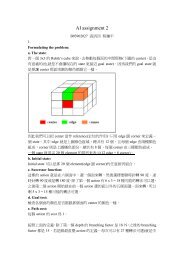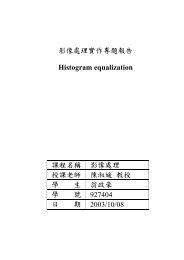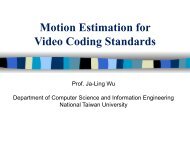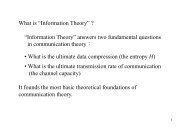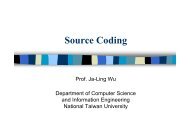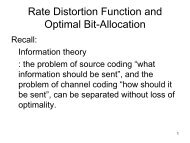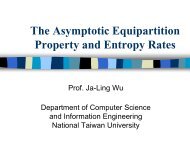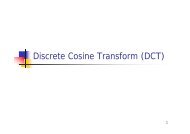Video Coding (MPEG-1)
Video Coding (MPEG-1)
Video Coding (MPEG-1)
You also want an ePaper? Increase the reach of your titles
YUMPU automatically turns print PDFs into web optimized ePapers that Google loves.
6. <strong>Video</strong> coding (Part 2)<br />
⎯<strong>MPEG</strong>-1<br />
Yi-Shin Tung<br />
National Taiwan University
Digital video compression<br />
People uses baseline JPEG to compress real-time video<br />
(motion JPEG, MJPEG).<br />
Adv: Symmetric, random access<br />
Disadv: compression<br />
Modern compression technology leads to compression rates<br />
of over 100-to-1.<br />
Master a video once and play it back many times. (100x<br />
computing power of the decoding process)<br />
<strong>Video</strong> Pixels Aspect Frame Bits/Pixel Uncomporessed<br />
Type<br />
Ratio Rate<br />
Bitrate<br />
NTSC 480x483 4:3 29.97 16 111.2Mb/s<br />
PAL 576x576 4:3 25 16 132.7Mb/s<br />
CIF 352x288 4:3 14.98 12 18.2Mb/s<br />
QCIF 176x144 4:3 9.99 12 3.0Mb/s<br />
HDTV 1280x720 16:9 59.94 12 622.9Mb/s<br />
HDTV 1920x1080 16:9 29.97 12 745.7Mb/s
Key factors for <strong>MPEG</strong> video quality<br />
Application definition<br />
The resolution of the original video source<br />
The bitrate of the transmission channel<br />
The adopted coding standards<br />
Encoding technology maturity<br />
Motion estimator effectiveness<br />
Mode decision effectiveness<br />
Region of interest (ROI)
Applications<br />
<strong>Video</strong> teleconferencing<br />
ITU standards: H.261 for ISDN videoconferencing, H.263 for<br />
POTS videoconferencing, and H.262 for ATM/broadband<br />
videoconferencing.<br />
Storing movies on CD-ROM<br />
ISO <strong>MPEG</strong>-1: 1.2Mb/s for video coding and 256kb/s for audio<br />
coding.<br />
Broadcast and storing video on DVD<br />
ISO <strong>MPEG</strong>-2: 2-15Mb/s for video and audio coding<br />
Low-Bit-Rate video telephony over POTS<br />
ITU H.324: 10Kb/s for video and as little as 5.3kb/s for audio<br />
coding
Applications<br />
Separate audio-visual objects<br />
<strong>MPEG</strong>-4: Scene description language, coding for both natural<br />
and synthetic.<br />
<strong>Coding</strong> of multimedia Metadata<br />
<strong>MPEG</strong>-7: data describing the features of the multimedia data.<br />
Using <strong>MPEG</strong>-2 for advanced HDTV<br />
15-400Mb/s for video coding.
<strong>MPEG</strong>: accomplishment<br />
<strong>MPEG</strong>-1: error free environments<br />
<strong>MPEG</strong>-2: broadcast TV<br />
<strong>MPEG</strong>-4: object based coding<br />
<strong>MPEG</strong>-7: multimedia description<br />
<strong>MPEG</strong>-21: seven element initiative for multimedia<br />
deployment, multimedia framework
<strong>MPEG</strong>: a new look<br />
<strong>MPEG</strong>-A: Multimedia application format<br />
Music player application, photo player application<br />
<strong>MPEG</strong>-B: <strong>MPEG</strong> systems technology<br />
Binary format for XML<br />
<strong>MPEG</strong>-C: <strong>MPEG</strong> video technology<br />
<strong>MPEG</strong>-D: <strong>MPEG</strong> audio technology<br />
<strong>MPEG</strong>-E: <strong>MPEG</strong> multimedia middleware<br />
U3D: Universal 3D file format
A Success Story: <strong>MPEG</strong><br />
Why <strong>MPEG</strong> succeeds?<br />
The concept of unique, application-independent, audio-visual<br />
information representation.<br />
Whoever made an investment to develop hardware or software<br />
implementing an <strong>MPEG</strong> standard knew that multiple client<br />
industries existed for his product.<br />
Three types of applications<br />
Storing-video<br />
Broadcast video<br />
<strong>Video</strong> conferencing
The <strong>MPEG</strong> Approach to<br />
Standardization<br />
Stick to the deadline<br />
A-priori standardization<br />
Not systems but tools<br />
Specify the minimum<br />
One functionality - one tool<br />
Relocation of tools<br />
Verification of standard
<strong>MPEG</strong> Style<br />
In the standard text, specify<br />
<strong>Video</strong> stream syntax<br />
Semantics for the syntax variables<br />
Decoding process<br />
Did not describe encoding process and algorithm<br />
inside the text, but put them in the test/reference<br />
model.<br />
<strong>MPEG</strong>-2, test model<br />
<strong>MPEG</strong>-4, verification model<br />
AVC, joint model
<strong>MPEG</strong>-1
Applications and requirements<br />
Applications<br />
<strong>Video</strong> on digital storage media, CD-ROM (VCD).<br />
Requirements<br />
<strong>Coding</strong> efficiency (best quality given a certain bitrate)<br />
Random access to a segment or a frame.<br />
Trick modes such as fast forward and fast reverse.<br />
Tradeoff between video quality and coding/decoding delay.<br />
Edit compressed bitstreams while keep decodability.<br />
Support a variety of video formats and image sizes.
Organization<br />
ISO<br />
International<br />
Organization for for<br />
Standardization<br />
SC :Sub Committee<br />
WG :Working Group<br />
JPEG :Joint Photographic<br />
<strong>Coding</strong> Experts Group<br />
MHEG :Multimedia and Hypermedia<br />
Information <strong>Coding</strong> Experts Group<br />
ISO/IEC JTC1<br />
ISO/IEC Joint Technical Committee<br />
SC1<br />
SC2<br />
SC29<br />
<strong>MPEG</strong> :Moving Picture Experts Group Multimedia<br />
<strong>Coding</strong> Area<br />
IEC<br />
International<br />
Electrotechnical<br />
Commission<br />
WG1(JPEG, JBIG)<br />
WG11(<strong>MPEG</strong>)<br />
WG11(<strong>MPEG</strong>)<br />
WG12(MHEG)
ISO/IEC 11172<br />
Information technology – <strong>Coding</strong> of moving pictures<br />
and associated audio for digital storage media at up<br />
to about 1.5 Mbit/s<br />
Part 1: Systems<br />
Part 2: <strong>Video</strong><br />
Part 3: Audio<br />
Part 4: Compliance testing<br />
Part 5: Simulation Software<br />
The official page: http://cselt.it/mpeg
Features<br />
<strong>MPEG</strong>/H.26x series standard<br />
Did not specify the encoding method.<br />
Specify the video bit stream.<br />
Specify the decoding semantics.<br />
Many “First”<br />
First integrated audio-visual coding standard<br />
First signal processing standard developed using software<br />
and described using "C“.<br />
First video coding standard independent of video format<br />
“bitrate”, “frame rate”, “no. of lines”, “no. of pixels/line”, etc.<br />
are “parameters”, whose overriding importance in the analog<br />
domain was reduced to size in the digital domain.
Reference Decoding Model for<br />
<strong>MPEG</strong>-1<br />
Source<br />
Delivery<br />
Demultiplexer<br />
<strong>Video</strong><br />
Audio
<strong>Coding</strong> Mechanism<br />
<strong>Coding</strong> methods in <strong>MPEG</strong>-1 Standard<br />
Color Space Conversion (lossy ,T.C)<br />
Motion Estimation/Compensation (lossless, P.C)<br />
DCT (lossless, T.C)<br />
Quantization (lossy, perceptual coding)<br />
VLC (lossless, E.C)<br />
DPCM in DC (lossless, P.C)<br />
Zigzag Scan (lossless, T.C)
<strong>MPEG</strong>-1 Encoding Flowchart<br />
R GB<br />
Y<br />
I Q<br />
To Other<br />
Color Space<br />
(Optional)<br />
Scan<br />
I-Frame DCT Quant Zig-Zag<br />
P B-Frame<br />
Motion<br />
Estatimation<br />
Y<br />
I Q<br />
Forward Frame Buffer<br />
Y<br />
I Q<br />
Backward Frame Buffer<br />
Different Image<br />
Reconstruct &<br />
Update<br />
IQuant<br />
IDCT<br />
DPCM<br />
RLE<br />
Motion<br />
Vector<br />
Huffman or<br />
Arithmetic<br />
<strong>Coding</strong><br />
01001...
Motion Compensation<br />
Motion Compensation<br />
using motion vector between current frame and reference<br />
frame to reconstruct the prediction of current frame<br />
Reference frame<br />
Current frame<br />
Reconstruct frame
Fractional motion compensation<br />
Motion compensation<br />
16x16 luma pels as a basic block.<br />
Half-pel motion is allowed. Bilinear interpolation filter is<br />
applied.<br />
PMV is computed, and the difference (MV−PMV) is<br />
encoded.<br />
The pel prediction error is coded using DCT-based<br />
intra-frame encoding.<br />
A B<br />
a b<br />
a = A<br />
b = (A+B+1)/2<br />
c d<br />
c = (A+C+1)/2<br />
C D<br />
d = (A+B+C+D+2)/4
Motion Estimation<br />
Motion Estimation<br />
88 84 83 84 85 86 83 82<br />
86 82 82 83 82 83 83 81<br />
82 82 84 87 87 87 81 84<br />
81 86 87 89 82 82 84 87<br />
81 84 83 87 85 89 80 81<br />
81 85 85 86 81 89 81 85<br />
82 81 86 83 86 89 81 84<br />
88 88 90 84 85 88 88 81<br />
Frame N<br />
84 82 83 81 85 86 83 81<br />
82 82 81 83 82 83 83 81<br />
83 82 84 87 87 87 81 88<br />
- 81 85 86 88 82 82 84 87 =<br />
81 84 85 87 85 89 84 81<br />
82 85 81 84 81 89 81 83<br />
81 87 86 83 86 89 81 84<br />
88 82 87 84 87 89 84 81<br />
Motion Vector<br />
Frame N+1<br />
-4 -2 0 -3 0 0 0 -1<br />
-4 0 -1 0 0 0 0 0<br />
1 0 0 0 0 0 0 4<br />
0 -1 -1 -1 0 0 0 0<br />
0 0 2 0 0 0 4 0<br />
1 0 -4 -2 0 0 0 -2<br />
-1 6 0 0 0 0 0 0<br />
0 -6 -3 0 2 1 -4 0
B-Frame<br />
The non-referable B-picture is introduced for<br />
increasing the frame rate without increasing too<br />
much bitrate.<br />
Bilinear filter is used for generating the predictor<br />
from forward and backward predictors.<br />
Forward<br />
prediction<br />
Backward<br />
prediction<br />
I or P B I or P
Quantization<br />
Default quantization matrices (intra and inter)<br />
Can be overwritten.<br />
Dead-zone design: Trade-off between bitrate and quality.<br />
Quantizer scale (qp) adjustable in the MB layer<br />
DC quantization: fixed quantizer<br />
Intra AC quantization: no dead-zone<br />
Inter AC quantization: dead-zone is used.<br />
Default intra quant table
itstream<br />
Recons.<br />
frame<br />
Modularized <strong>MPEG</strong>-1/2 decoding<br />
process<br />
VR<br />
FU<br />
Configuration data<br />
syntax vlc table<br />
SYNP<br />
FU<br />
IT<br />
FU<br />
IQ<br />
FU<br />
Parsing & Decoding FUs<br />
VLD FU RLD FU MBG FU<br />
CS<br />
Global<br />
Control<br />
Unit<br />
CI<br />
FFR<br />
FU<br />
MC<br />
FU<br />
IS<br />
FU<br />
MVR<br />
FU<br />
Macroblock based FUs<br />
DCR<br />
FU<br />
MB data
Bitstream Structure<br />
All headers start with a value of 000001XX H .<br />
Sequence Layer<br />
Group of picture (GOP) Layer<br />
Picture Layer<br />
Slice Layer<br />
Macroblock Layer (no header)<br />
Block (no header)<br />
Marker bit<br />
Prevent start-code emulation<br />
Can be used for error detection
Sequence Layer<br />
Information in the Sequence Header:<br />
horizontal and vertical size<br />
aspect ratio<br />
frame rate<br />
bit-rate<br />
buffer size<br />
B = 16 × 1024×<br />
vbv _ buffer _ size<br />
Constrained Parameter Set Flag<br />
compressed<br />
video data<br />
from channel<br />
buffer<br />
to<br />
decoder
Constrained Parameter Set (CPS)<br />
Most people thought <strong>MPEG</strong>-1 as CPS <strong>MPEG</strong>-1.<br />
A subset of <strong>MPEG</strong>-1 for interoperability.<br />
Parameter Value<br />
Horizontal Size ≤768<br />
Vertical Size ≤576<br />
No. of MB/picture ≤396<br />
No. of MB/sec ≤9900 (396×25)<br />
Picture Rate ≤30Hz<br />
Interpolated Pictures ≤2<br />
Bitrate ≤1856kbit/s<br />
VBV buffer ≤40kB
GOP Layer<br />
I,P,B three types of picture to consist a GOP<br />
Time code<br />
Closed GOP<br />
Broken GOP<br />
Typically ½ sec for a GOP<br />
Playback control (fast playback, pause mode, reverse<br />
playback)
Picture Layer<br />
Information in the Picture Header<br />
Temporal Reference (10bit)<br />
Picture coding type (I frame, P frame, B frame, D frame)<br />
vbv_delay<br />
t( n)<br />
=<br />
DTS(<br />
n)<br />
− vbv _ delay(<br />
n)<br />
Full-pel motion vector, f_code (mv_range)
GOB Layer<br />
Information in GOB header<br />
Slice_vertical_position, (00000101~000001AF H)<br />
Quantizer scale (5 bit)<br />
Macroblock Line (Group Of Block)<br />
Convenient to perform error concealment when transmission<br />
error occurs.
Macroblock Layer<br />
An MB has<br />
16x16 luminance pel<br />
8x8 chrominance pel<br />
basic unit for Motion Estimation<br />
Information in MB header<br />
Address increment<br />
MB type<br />
quantizer if provided<br />
Forward/backword<br />
motion if provided<br />
cbp if provided<br />
P macroblock type
Block Layer<br />
Block : 8 pixels by 8 lines<br />
basic unit for DCT<br />
DC coding (dc_size + dc_diff)<br />
2D run length coding<br />
dct_coeff_first<br />
dct_coeff_next<br />
escape code followed by FLC<br />
end_of_block<br />
Quantization with dead-zone
I,P,B Frame<br />
Difference between picture types<br />
I frame P frame B frame<br />
Compression Ratio Low Good Best<br />
Random Access Best Hard Hardest<br />
Complexity normal high highest
D frame (DC-only frame)<br />
Only DC components of DCT coefficients are coded.<br />
Frames coded as a stand-alone still image.<br />
D frames are rarely used in the existing <strong>MPEG</strong>-1<br />
videos.<br />
For browsing, database applications.
<strong>MPEG</strong>-1 System Decoder<br />
<strong>Video</strong> is finally up-sampled to NTSC/PAL
11172-3<br />
Specify coded<br />
representation of<br />
compressed audio<br />
both mono and<br />
stereo.<br />
Support three layers<br />
Applications<br />
Radio broadcasting<br />
at CD quality<br />
Music distribution<br />
on the Web
Compliance Testing(Part 4)<br />
Tests to verify whether bitstreams and decoders<br />
meet the standard.<br />
Manufacturers of encoders to verify the valid bitstreams.<br />
Manufacturers of decoders to verify if the the decoder<br />
meets the standard requirements for claimed decoder<br />
capabilities.<br />
Applications to verify whether the characteristics of the<br />
bitstream meet the application requirements.
Software Simulation(Part 5)<br />
Include<br />
A complete software implementation of the standard<br />
decoder<br />
An example software encoder<br />
Influence the development of the MMX.<br />
Supports typical computation-intensive video-coding<br />
operation.
Reading assignment<br />
Mandatory<br />
Digital <strong>Video</strong>: An Introduction to <strong>MPEG</strong>-2, Chapter 7<br />
“motion compensation modes in <strong>MPEG</strong>” and Chapter 8<br />
“<strong>MPEG</strong>-2 video coding and compression”.<br />
Optional<br />
<strong>Video</strong> Demystified, Chapter 12 “<strong>MPEG</strong>-1”
Homework<br />
4. Study the fields, vbv_buffer_size and vbv_delay, for CBR/VBR<br />
video sequences. Describe the buffer handling mechanism for<br />
seeking and tricky mode. Write a program for analyzing the existing<br />
<strong>MPEG</strong>-1(<strong>MPEG</strong>-2) video for reporting vbv conformance, minimal<br />
vbv buffer requirement.





